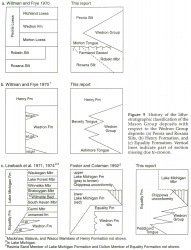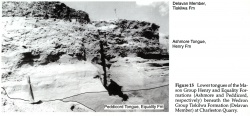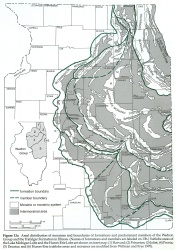Ashmore Tongue
Lithostratigraphy: Mason Group >>Henry Formation >>Ashmore Tongue
Chronostratigraphy: Cenozoic Erathem >>Quaternary System >>Pleistocene Series
Primary source
Hansel, Ardith K., and W. Hilton Johnson, 1996, Wedron and Mason Groups: Lithostratigraphic Reclassification of Deposits of the Wisconsin Episode, Lake Michigan Lobe Area: Illinois State Geological Survey Bulletin 104, 116 p.
Contributing author(s)
Ardith K. Hansel and W. Hilton Johnson
Name
Original description
Ashmore Member, Wedron Formation (Ford 1973).
Derivation
Ashmore, a village in Coles County, east-central Illinois.
Other names
History/background
Ford proposed the Ashmore Member in 1973 for the sequence of stratified sediment (laminated silt and organic matter, and sand and gravel) at the base of Wedron Formation diamicton in the Charleston Stone Quarry pits along both sides of the Embarras Valley. He found the clay-mineral and carbonate compositions of the basal silt of the Ashmore Member to be similar to that of the overlying diamicton and the upper part of the sand and gravel to be intercalated with the diamicton in places. Wood from a log embedded in laminated silt of the Ashmore Member yielded a radiocarbon age of 19,500 years before present. Ford (1973) correlated the Ashmore Member with basal laminated silt reported by Johnson et al. (1971a) in the Wedron Formation at Shelbyville and basal laminated silt in the Wedron Formation at the Harmattan Strip Mine Section near Danville (Johnson et al. 1972). Ford (1973) reported that the sand and gravel of the Ashmore Member is widely distributed in the subsurface in Coles County, where it is up to 10 meters (33 ft) thick and commonly constitutes an important sand and gravel resource, as well as the most widespread, productive aquifer of the area. Kempton et al. (1982) later used the name "Ashmore" to refer to the aquifer at the base of the Wedron Formation.
The concept of a lithostratigraphic unit for the stratified, sorted sediment at the base of the Wedron sequence was also used at the Wedron Formation type section (Johnson et al. 1985a, Hansel et al. 1987; Johnson and Hansel 1990), where the basal sand and gravel was included with laminated clay and silt as part of the Peddicord Formation (interpreted to be proglacial sediment associated with the Lake Michigan Lobe advance during the Michigan Subepisode). In this revision we are treating the bedded, sorted sediment that interfingers with the diamicton formations of the Wedron Group as tongues of the sorted sediment units; therefore, the former Ashmore Member is classified in this report with the Henry Formation of the Mason Group rather than with the Wedron Group (fig. 9b). As redefined, the Ashmore Tongue includes only the bedded, sorted sediment that is coarse grained (predominantly sand and gravel); the fine textured facies (predominantly silt and clay) of the original Ashmore Member is classified herein as the Peddicord Tongue of the Equality Formation.
Type section
Type location
Charleston Section (fig. 15), Charleston Stone Quarry pits, located on both sides of the Embarras Valley about 8 kilometers (5 mi) east-northeast of Charleston; good for boundaries and lithology.
Type author(s)
Type status
Reference section
Reference location
Wedron Section (fig. 12); good for boundaries and lithology.
Reference author(s)
Reference status
Stratigraphic relationships
The Ashmore Tongue is the stratified sand and gravel of the Henry Formation that extends beneath the basal red gray diamicton unit of the undivided Tiskilwa Formation or the gray diamicton unit of the Delavan Member of the Tiskilwa Formation. In places it is interfingered with other units of the Mason Group, for example, the Peddicord Tongue (Equality Formation) and the Morton Tongue (Peoria Silt).
The stratified sequence of the Ashmore Tongue is generally readily distinguishable from both the nonbedded silt of the Morton Tongue (Peoria Silt) and the more organic, leached, stratified silt of the Robein Member (Roxana Silt). The contact of the coarser grained Ashmore Tongue with the finer grained Peddicord Tongue is sometimes gradational and /or interfingered. The stratified Ashmore Tongue can generally be readily differentiated from massive diamicton of Tiskilwa Formation, but in places the stratified sediment contains diamicton lenses and beds. In such places an erosional contact often occurs at the base of the more massive diamicton of the Tiskilwa Formation and serves to separate the Ashmore Tongue, which may contain interbeds of diamicton in its upper part.
Extent and thickness
The Ashmore Tongue is present as a discontinuous subsurface unit at the base of the Tiskilwa Formation in the Harvard, Princeton, Peoria, and Decatur Sublobe areas of Illinois. It is up to 10 meters (33 ft) thick in some areas.
Lithology
The Ashmore Tongue consists of fingers and lentils of medium to coarse textured, stratified sediment, predominantly sand and gravel, that are overlain by diamicton of the basal part of the Tiskilwa Formation; the upper part of the sequence may contain intercalated diamicton lenses and tongues. Detrital organic matter is sometimes found within the stratified sediment. The pebble and carbonate composition of the Ashmore Tongue is similar to that of Tiskilwa Formation diamicton.
Core(s)
Photograph(s)
Contacts
Lower boundary: the contact with the Peddicord Tongue (Equality Formation), the Morton Tongue (Peoria Silt), the Robein Member (Roxana Silt), or older units. Upper boundary: the contact with Peddicord or Morton Tongues, diamicton of the Delavan Member, or undivided Tiskilwa Formation.
Well log characteristics
Fossils
Age and correlation
The Ashmore Tongue was deposited as the Tiskilwa ice margin advanced to its maximum position first in the Harvard Sublobe area (Marengo Moraine) and later in the Princeton, Peoria, and Decatur Sublobe areas (outer moraines of the Bloomington and Shelbyville Morainic Systems) between about 26,000 and 19,500 radiocarbon years ago (figs. 9, 13). It correlates with equivalent Henry Formation beyond the outer Wedron Group boundary, the lower stratified part of the Tiskilwa Member of the Zenda Formation in Wisconsin (Mickelson et al. 1984), and part of the Atherton Formation in Indiana (Wayne 1963).
|
Environments of deposition
The Ashmore Tongue is the basal fluvial facies of a glacigenic sequence that contains Tiskilwa Formation. The proglacial facies might include for example a coarsening upward succession interpreted to be loess (Morton Tongue), glaciolacustrine clay and silt (Peddicord Tongue), and glaciofluvial sand and gravel (Ashmore Tongue) that is overlain by ice-marginal redeposited sediment and till of the undivided Tiskilwa Formation or the Delavan Member.
Economic importance
Remarks
Redefined, reclassified, and redescribed unit. Name changed to Ashmore Tongue, unit reclassified as part of the Henry Formation, and description modified to include only medium to coarse grained, stratified sediment. Formerly classified as the Ashmore Member of the Wedron Formation (Ford 1973).
References
FORD, J., 1973, Surficial Deposits of Coles County, Illinois: Illinois State Geological Survey Open File Report, 73 p.
HANSEL, A. K., W. H. JOHNSON, and B. J. SOCHA, 1987, Sedimentological characteristics and genesis of basal tills at Wedron, Illinois, International Union for Quaternary Research Till Symposium, Finland 1985: Geological Survey of Finland Special Paper 3, p. 11-21.
JOHNSON, W. H., H. D. GLASS, D. L. GROSS, and S. R. MORAN, 1971a, Glacial Drift of the Shelbyville Moraine at Shelbyville, Illinois: Illinois State Geological Survey Circular 459, 23 p.
JOHNSON, W. H., L. R. FOLLMER, D. L. GROSS, and A. M. JACOBS, 1972, Pleistocene Stratigraphy of East-Central Illinois: Illinois State Geological Survey Guidebook 9, 97 p.
JOHNSON, W. H., and A. K. HANSEL, 1990, Multiple Wisconsinan glacigenic sequences at Wedron, Illinois: Journal of Sedimentary Petrology, v. 60, no. 1, p. 26-41.
JOHNSON, W. H., A. K. HANSEL, B. J. SOCHA, and L. R. FOLLMER, 1985a, The Wedron Section, Stop 1, in W. H. Johnson, A. K. Hansel, B. J. Socha, and J. M. Masters, Depositional Environments and Correlation Problems of the Wedron Formation (Wisconsinan) in North-eastern Illinois: Illinois State Geological Survey Guidebook 16, p. 13-42.
KEMPTON, J. P., W. J. MORSE, and A. P. VISOCKY, 1982, Hydrogeologic Evaluation of Sand and Gravel Aquifers for Municipal Groundwater Supplies in East-Central Illinois: Illinois State Geological Survey and Illinois State Water Survey Cooperative Groundwater Report 8, 59 p.
MICKELSON, D. M., L. Clayton, R. W. BAKER, W. H. MODE, and A. F. SCHNEIDER, 1984, Pleistocene Stratigraphic Units of Wisconsin: Wisconsin Geological and Natural History Survey Miscellaneous Paper 84-1, 107 p.
WAYNE, W. J., 1963, Pleistocene Formations of Indiana: Indiana Geological Survey Bulletin 25, 85 p.
ISGS Codes
| Stratigraphic Code | Geo Unit Designation |
|---|---|



